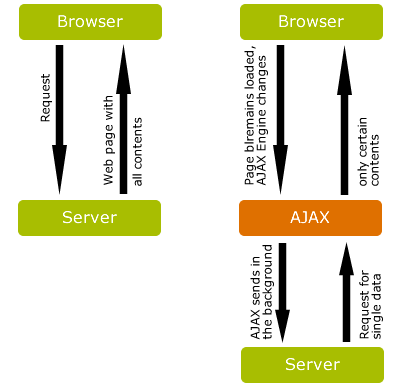16. November 2008
Veröffentlicht in Uncategorized | Kommentare deaktiviert für We are the Web
07. November 2008
New programming techniques allow of individual data exchange with the server:
- GoogleMail reports without reload when new messages have arrived.
- Writely, the online word processing programme, opens contact menus after right click.
- Google Maps zooms maps without resending the entire request to the server.
- The web is more and more turning into an application, offering look & feel of programmes locally installed on the PC.
- The secret is the new technology called Ajax.
- Ajax stands for „Asynchronous JavaScript and XML“.
- The combination of these two techniques allows the exchange of only specifically requested data between browser and server.
- Ajax provides for new contents on the website without having to completely reload it.
- The traditional web organisation in sites is taken over by new web applications as fast as desktop software.
- In addition, Ajax enables the mixing up of different web offers since data can derive from diverse sources.
(According to O’Reilly: Web 2.0 for Participation)
Veröffentlicht in Uncategorized | Kommentare deaktiviert für Ajax or the new interaction of web applications
03. Oktober 2008
In order to handle software regardless of device boundaries, it is essential to have open interfaces:
- Web 2.0 is open.
- Most applications are based on Open Source software.
- By using open interfaces (APIs) offers and data can be combined with each other.
- RSS Feeds and Widgets allow for the integration of contents on special sites.
- Standards are given and are constantly being further developed by the World Wide Web Consortium.

|
| Open interfaces combine different offers. |
(According to O’Reilly: Web 2.0 for Participation)
Veröffentlicht in Uncategorized | Kommentare deaktiviert für Open interfaces allow for the linking of offers
19. September 2008
While for computer programmes beta versions are always recognizable as test versions which need further development, web applications can be constantly up-dated – in other words, on web 2.0 everything remains „beta“:
- Devices and applications keep connecting themselves to the internet.
- Internet applications are not software artefacts anymore but they become permanent services.
- New features are permanently being introduced, becoming part of the everyday „user experience“.
- Users become real time testers, their behaviour informs about the quality of the product update.
- Shorter „time to market“.
- Reduced risk.
- Closer bond with the user.
- Real time data for taking quantifiable decisions.

|
| „Release early and release often“. |
|

|
| Short software cycles are the critical factor of success on Web 2.0. |
|

|
| Comparison of the Release Histories of Microsoft Windows and Flickr. |
(According to O’Reilly: Web 2.0 for Participation)
Veröffentlicht in Uncategorized | Kommentare deaktiviert für End of software cycles (perpetual beta)
03. September 2008
Veröffentlicht in Uncategorized | Kommentare deaktiviert für Share and cooperate – User Generated Content















